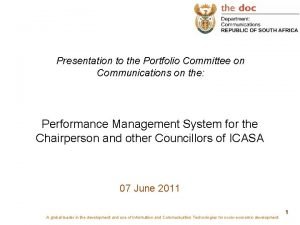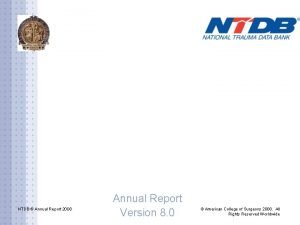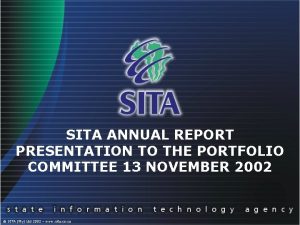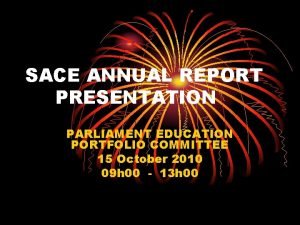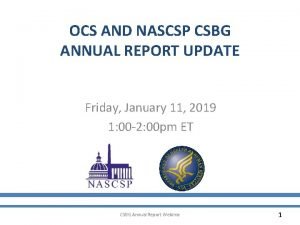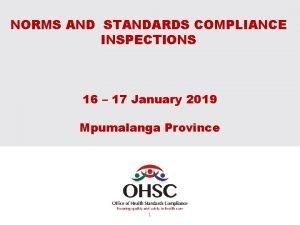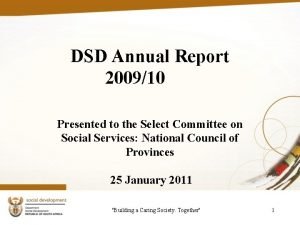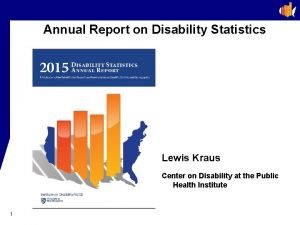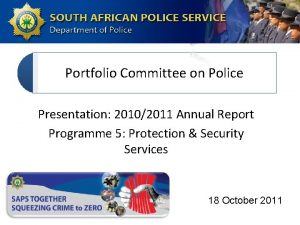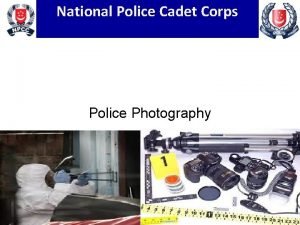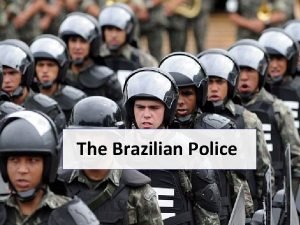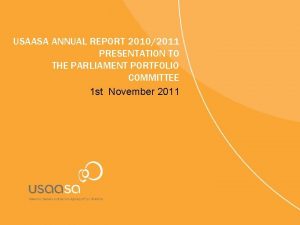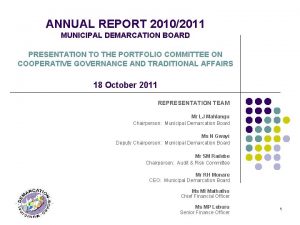Portfolio Committee on Police Presentation 20102011 Annual Report

































- Slides: 33

Portfolio Committee on Police Presentation: 2010/2011 Annual Report Programme 2: Visible Policing 13 October 2011

Index v Expenditure Programme 2: Visible Policing v Actual performance against targets 2

Expenditure Programme 2: Visible Policing

Programme 2: Visible Policing Sub-Programmes Actual 2009/10 Actual 2010/11 R’ 000 Crime Prevention Borderline Security Specialised Interventions 17 920 826 217 779 1 631 261 19 943 985 194 675 1 563 967 TOTAL 19 769 866 21 702 627 {Specialised Interventions consists inter alia of Public Order Policing, National Intervention Units, Tactical Response Teams, Special Task Force, Air Wing etc. } Purpose: Enable police stations to institute and preserve safety and security, and provide for specialised interventions and the policing of South Africa’s borderlines. 4

Programme 2: Visible Policing v Main 2010/11 spending priorities accomplished Spending priority Spending performance Number of personnel Progress Increase from R 19, 8 billion to R 21, 7 billion Programme 2: Visible Policing Total establishment figure for this programme is 97 693 Crime prevention Include Reservists R 93, 9 million, Mounted Units R 66, 3 million, Dog Units R 495, 7 million, 10111 Centres & Flying Squad R 659, 2 million and Detainees R 231, 1 million (meals and medical) Borderline security R 194, 7 million spent of which R 166, 0 million was spent on operational aspects such as detached duties, vehicles, vessels and fuel and oil Specialised interventions Include Task Force R 55, 3 million, Public Order Policing & National Intervention Units R 1, 048 billion, Tactical Response Teams R 26, 7 million and Air Wing R 152, 1 million. Additional helicopter procured to the value of R 30, 9 million Fuel and oil for this programme a mentionable R 904, 8 million 2010 Soccer World Cup Approximately R 642 million spent on the security deployments for the 2010 Soccer World Cup 5

Actual performance against targets

Programme 2: Visible Policing Actual performance against target (Annual Report pages 56 - 58) Objective, Priority & Indicator Target Actual Performance Reason for Variance Objective To discourage all crimes by providing a proactive and responsive policing service that will reduce the levels of priority crimes. An additional 79 police stations rendering a victim friendly service in 2010/11 10 additional Victim Support Rooms (VSRs) were established at police stations namely at: • Jane Furse; • Botlhokwa; • Zamdela; • Pienaar; • Brakpan (Tsakane) ; • Thokoza; • Mbuzini; • Hazyview; • Blue Downs; and • Giyani police stations. Target not achieved. Priorities 1. More policeable crime 2. Contact crime 3. Crimes dependent on police action for detection Indicator : Number of police stations rendering a victim friendly service to victims of rape, sexual offences and abuse Due to other priorities that had to be funded, including the 2010 FIFA World Cup TM, funding could not be allocated for the establishment of VSRs in 2010/11. A budget will be allocated for this purpose during the following financial years. 7

Objective, Priority & Indicator : Number of crime prevention actions conducted by police stations focusing on: • legal and illegal firearms • illegal drugs • stolen / robbed vehicles Target Conduct a minimum of 25 000 crime prevention actions in 2010/11. Actual Performance 29 891 crime prevention actions were conducted. These include intelligence driven operations, targeting 'hot spot' areas, according to the Crime Pattern Analysis (CPA) and Crime Threat Analysis (CTA) in order to prevent or reduce the levels of crime. Reason for Variance Target achieved. 8

Objective, Priority & Indicator: Rate of all serious crime, contact crimes and trio crimes Indicator : Number of escapes from police custody Target Actual Performance Reason for Variance All serious crime to be reduce by between 1 to 1. 8% by 2010/11 All serious crime reduced by -2. 4% Target achieved. Contact crimes reduced to 1 288 per 100 000 of the population. Contact crimes reduced to 1 277 per 100 000 of the population. Target achieved. Trio crimes reduced to 90 per 100 000 of the population by 2010/11 Trio crimes reduced to 84 per 100 000 of the population. Target achieved. Decrease the number of incidents of escapes from police custody by 50% in 2010/11. Decreased by 20. 6%. 478 escape incidents occurred in 2010/11 during which 669 persons escaped from police custody compared to 602 incidents in 2009/10 during which 857 persons escaped. Target not achieved Although there has been a decrease in the number of incidents of escapes, the target could not be achieved due to the fact that, since escapes were identified as a strategic priority risk, measures and mechanisms put in place in that regard, were not yet cascaded down to police station level during 2010/11, as this process was scheduled to be fully implemented during 2011/12. 9

Objective, Priority & Indicator Objective To secure borderlines by focusing on arrests and seizures in respect of the following prioritised crime: Priorities • Criminal organisations involved in crimes relating to firearms, vehicles, drugs and illegal goods • Violations in terms of the Immigration Act • Corruption • Marine life resources • Precious metals and stones • Illegal smuggling and trafficking of humans Target Conduct a minimum of 350 policing actions in 2010/11. Actual Performance Reason for Variance 261 policing actions were conducted in 2010/11. These include joint operations, cross border operations, assistance to other police components along the borders and follow-up operations. Target not achieved due to the commitment of members to the 2010 FIFA World Cup TM and the withdrawal of SAPS members from borderline bases which were handed over to the SANDF. Indicator: Number of policing actions at borderlines focusing on prioritised crime. 10

Objective, Priority & Indicator Target Actual Performance Objective To provide a rapid response capability for intervening in dangerous and potentially dangerous situations where normal policing must be supported, including the following: Stabilise 95% incidents in 2010/11 97. 2% incidents were successfully stabilised during 2010/11 (14 807 incidents were attended to, of which 14 387 were stabilised). Reason for Variance Target achieved. Priorities • Serious and violent crime incidents • Public gatherings and marches • Hostage situations Indicator: Number of medium to high-risk incidents stabilized. 11

Crime Prevention

Victim-friendly service delivery by police stations v Stations were required in an instruction issued in December 2011 to ensure that they all render a victim-friendly service by utilising the following measures: • Ensuring that members deployed for duties that require them to serve victims of crime are trained in the following courses: o Victim empowerment training programme o Domestic Violence learning programme o First Responders to Sexual Offences learning programme o Vulnerable Children learning programme • Establishing a dedicated victim support room at the police station; and/or • Issuing a station order to make provisions for service to victims, including arrangements for taking statements in privacy in the absence of a dedicated Victim Support room, and transporting victims. 13

SAPS 13 Firearms v Number of firearms in SAPS 13 stores reduced from: • 210 451 in March 2010 to 179 574 in March 2011 15

Sector Policing Implementation Plan v 209 Provincial Priority police stations identified by the Provincial Commissioners to be implemented by 30 June 2010. v Only 208 police stations reportedly implemented sector policing by 30 June 2010. v SAPS Tarlton, a newly established police station (December 2009), experienced challenges. As a result, Sector Policing at Tarlton was only established by 30 September 2010. 16

All police stations implementation status at the end of the 4 th Quarter 2010/2011 Province Number of police stations Total number of police stations implemented Total number of police stations outstanding Gauteng 135 120 15 Kwa. Zulu-Natal 184 146 38 Western Cape 149 135 14 Eastern Cape 191 187 4 North West 81 74 7 Mpumalanga 86 83 3 Free State 110 86 24 Limpopo 93 74 19 Northern Cape 91 81 10 1 120 986 134 Total 17

Reservists v A moratorium on the recruitment of reservists was in place from 1 April 2009 until 10 December 2009, and was lifted by the Minister of Police and the National Commissioner. v The South African Police Service has, however not enlisted new reservists pending the review of the reservist system that was undertaken. v The purpose of the review was to improve the process for utilization and management of reservists, and to adopt new enhanced criteria for the selection and recruitment. 18

Implementation & roll out of the reservist system v 1 245 qualifying reservists were appointed in 2010/11 in terms of the SAPS Act and 332 in terms of PSA v The National Commissioner approved the establishment of a National Task Team to facilitate the implementation and roll out of the revised reservist system v The new reservist system will be implemented in two (2) phases: • Phase 1 - Phasing out of existing reservist system • Phase 2 - Implementation of the new reservist system • Implementation of the new system through joint provincial information sessions • A recruitment drive to address the possible vacuum that might be created due to the termination of the appointment of reservists that no longer meet with set standards and requirements. v The two phases will be implemented concurrently. v Bi-annual structured recruitment drives will be implemented from February 2012 19

Rural Safety Strategy v A Rural Safety Plan was implemented to address the phasing out of the SANDF Commando System. v During 2010/2011, this strategy was reviewed to accommodate the following concerns: • Borderline policing approach • Need for improving responses to the high number of incidents of crime in rural areas, stock theft, also across borders • Accommodate changes in the use of reservists 20

Establishment of Community Police Forums v All police stations have established CPFs. v A training programme was developed to ensure that all CPF members, newly appointed and existing, share a common understanding of the functioning of these structures. v SAPS continues to support CPFs in terms of the Interim Regulations for Community Police Forums and Boards. v Where office space is available at stations or provincial offices, CPFs are accommodated to execute their duties and transport is also afforded to the CPF to execute their duties. 21

Gender-based Violence v. The SAPS is responsible for the Monitoring and Evaluation of the implementation of the Domestic Violence Act at Provinces, Cluster and Police Station level. v. As part of the M & E Framework, police stations are identified and prioritised for visits during the year for the purpose of assessing compliance with visible policing prescripts. v. During the 2010/2011 financial year, 58 compliance visits were conducted. v. Shortcomings found during these visits were addressed through inservice training. Corrective actions and feedback was also given. v. Reports in terms of Section 18 of the DVA were submitted up to December 2010. These included non-compliance by members, the disciplinary proceedings instituted and steps taken as a result of recommendations made by the IPID. 22

Addressing firearm application backlog v The Minister commissioned an enquiry into the functioning of the CFR during June 2010. v As part of implementing the recommendations thereof, a project was constituted to address the backlog within the CFR to be completed during 2011/12 23

Firearm Control Amendment Act, Act No. 28 of 2006 v The Firearm Control Amendment Act has been implemented on the 10 January 2011 v The following sections were amended and implemented: • Section 3 of Act 60 of 2000 (Definition of muzzle loading firearm) • Section 5 of Act 60 of 2000 (Substitution of antique firearm with muzzle loading firearm) • Section 9 of Act 60 of 2000 (Application for competency certificate for muzzle loading firearm) • Section 10 of Act 60 of 2000 (Possession of a muzzle loading firearm renewal of a competency certificate) • Section 18 of Act 60 0 f 2000 ( Validity period of licenses, permits and authorizations) • Section 52 of Act 60 of 2000 (Application for competency certificates for muzzle loading firearm) 24

Borderline Security

Quantitative differences in the number of arrests and confiscations in 2008/09, 2009/10 and 2010/11 Arrests for 2008/2009/2010/2011 Firearms 156 115 120 Vehicles 95 76 35 Drugs 348 554 512 Illegal goods 80 207 304 50 153 38 892 20 175 Undocumented persons / aiding and abetting 26 26

Seizures in terms of 2008/2009/2010/2011 Firearms 265 179 149 Vehicles 530 340 305 174 270 kg 87 175 kg 46 493 kg Drugs v The high visibility and vigilance of deployed members at the borderlines during the three comparative years resulted in the decrease of the arrest and seizure of firearms, vehicles and undocumented persons. Thus, criminals use alternative routes when noticing high visibility - they take less chances with firearms and stolen vehicles. The Zimbabweans were also granted concessions, so even if they had no documents they were not arrested but taken to the nearest Home Affairs office. v There was an increase in the arrest and seizure of drugs and illegal goods due to the improved search methods and equipment used by members. 27 27

Status (as at 31 March 2011) in terms of the taking over of the borderlines by the SANDF v The following bases have been handed over to the SANDF without any outstanding issues: v Pontdrift v Musina v Sandrivier v Macadamia v Ndumo v Ladybrand (divided into two zones of responsibility of SAPS and SANDF) until total take over v Pongola v Rooibokkraal v Swartwater v Madimbo v Zonstraal 28 28

Beitbridge, Muzi and Blenheim closed down in totality with no deployment v Beitbridge – SAPS withdrawn in totality and SANDF took responsibility for the whole of Limpopo Province borderline. v Muzi – The base was handed over to SANParks. v SANDF took over the Northern Natal/ Mozambique borderline. v Blenheim – The base was situated on a farm and it burnt down completely on the 21 st May 2009, the members were transferred to nearby Zastron base which was later handed over to the SANDF. 29

Specialised Interventions

Public Order Policing Crowd management incidents : Peaceful Unrest Total 2008/2009 6 222 743 6 965 2009/2010 7 913 994 8 907 2010/2011 11 680 971 12 651 31

Public Order Policing v 2009/2010 to 2010/2011: Increase in peaceful gatherings is ood to attributed stakeholders as determined by Section 4 of the Gathering Act. v 2008/2009 to 2010/2011: Increase in unrest related incidents is attributed to unauthorised, unplanned, and spontaneous gatherings whereby no opportunity was afforded for stakeholders to plan and put in place security measures. 32

SAPS Air Wing v 8463. 3 hours were flown in 2010/11 (6 715 hours for crimerelated matters. v Flying hours are being allocated according to a 20% communication hours and 80% crime prevention hours principle. v The 80% crime prevention hours include call-out to crime incidents as well as hours flown for planned operations. v 20% communication hours are used for the training of pilots, maintenance flights, air shows and VIP transport. 33

Special Task Force Breakdown of interventions conducted during 2010/11 v Total operations conducted in 2010 / 2011: 196 – Hostage situations: 30 – Hostages released: 23 – Urban/rural terror: 2 – Organised crime: 66 – Serious crime: 27 – Crimes against women and children: 0 – Search and rescue operations: 15 – VIP and protection assistance: 19 – Other operations: 14 v 116 successfully resolved v 68 potential incidents - did not materialise 34
 Portfolio committee
Portfolio committee Portfolio committee on mineral resources and energy
Portfolio committee on mineral resources and energy Portfolio committee on basic education
Portfolio committee on basic education Portfolio committee on communications
Portfolio committee on communications Portfolio committee on basic education
Portfolio committee on basic education Portfolio committee on higher education
Portfolio committee on higher education National trauma data bank annual report 2020
National trauma data bank annual report 2020 Compal electronics inc annual report
Compal electronics inc annual report Annual investment income report
Annual investment income report Sita annual report
Sita annual report Sen annual review report example
Sen annual review report example Cic annual report 2019
Cic annual report 2019 Kantar annual report
Kantar annual report Electranet annual report
Electranet annual report Pqr gmp requirements
Pqr gmp requirements Tceq p2 annual progress report
Tceq p2 annual progress report Sma annual report
Sma annual report Quiksilver
Quiksilver Diploma annual report
Diploma annual report Namco cybertainment inc
Namco cybertainment inc Annual status of education report
Annual status of education report Irlebird
Irlebird Sace annual report
Sace annual report Csbg annual report
Csbg annual report Jrc annual report
Jrc annual report Annual report conclusion
Annual report conclusion Ohsc inspection tools
Ohsc inspection tools Dsd annual report
Dsd annual report Disability statistics annual report
Disability statistics annual report Eusa room bookings
Eusa room bookings Huntersville police department
Huntersville police department Police report that 78 of drivers are given a breath test
Police report that 78 of drivers are given a breath test Sparks nevada police department
Sparks nevada police department Prince william county police report online
Prince william county police report online



